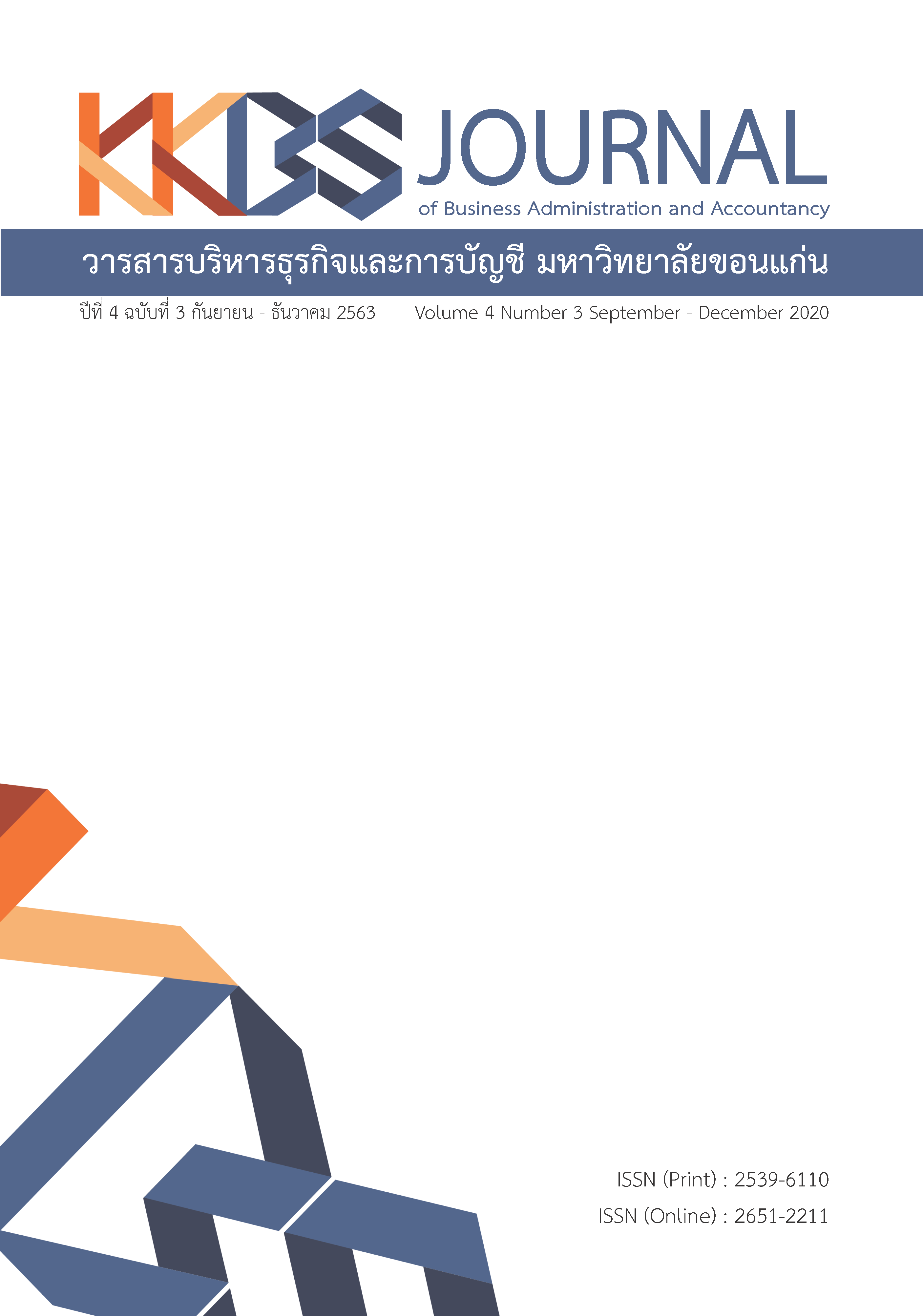แบบจำลองพฤติกรรมการสร้างสรรค์นวัตกรรมของพนักงานกลุ่มอุตสาหกรรมไฟฟ้าและอิเล็กทรอนิกส์ ในเขตนิคมอุตสาหกรรม จังหวัดชลบุรี
Main Article Content
บทคัดย่อ
การศึกษาครั้งนี้มีวัตถุประสงค์พัฒนา และตรวจสอบแบบจำลองความสัมพันธ์เชิงสาเหตุพฤติกรรมการสร้างสรรค์นวัตกรรมของพนักงาน กลุ่มอุตสาหกรรมไฟฟ้าและอิเล็กทรอนิกส์ ในเขตนิคมอุตสาหกรรม จังหวัดชลบุรีกับข้อมูลเชิงประจักษ์ กลุ่มตัวอย่างที่ใช้ในการศึกษาคือ พนักงานระดับหัวหน้างาน กลุ่มอุตสาหกรรมไฟฟ้าและอิเล็กทรอนิกส์ ซึ่งไม่ทราบขนาดจำนวนประชากรที่แน่นอน ใช้วิธีการกำหนดขนาดกลุ่มตัวอย่างจากจำนวนตัวแปรสังเกตได้ กำหนดกลุ่มตัวอย่างได้ 300 คน และเครื่องมือที่ใช้ในการเก็บรวบรวมข้อมูลเป็นแบบสอบถาม สถิติที่ใช้คือ การวิเคราะห์สมการโครงสร้าง ผลการศึกษาพบว่า ลักษณะโครงสร้างองค์กร วัฒนธรรมองค์กร และการแบ่งปันความรู้มีอิทธิพลโดยตรงต่อพฤติกรรมการสร้างสรรค์นวัตกรรมของพนักงาน อีกทั้ง ลักษณะโครงสร้างองค์กร และวัฒนธรรมองค์กรมีอิทธิพลต่อพฤติกรรมการสร้างสรรค์นวัตกรรมของพนักงานโดยส่งอิทธิพลผ่านการแบ่งปันความรู้ และลักษณะผู้นำมีอิทธิพลต่อพฤติกรรมการสร้างสรรค์นวัตกรรมของพนักงานโดยส่งอิทธิพลผ่านลักษณะโครงสร้างองค์กร วัฒนธรรมองค์กร และการแบ่งปันความรู้ นอกจากนี้ อิทธิพลของลักษณะผู้นำ ลักษณะโครงสร้างองค์กร วัฒนธรรมองค์กร และการแบ่งปันความรู้ สามารถทำนายพฤติกรรมการสร้างสรรค์นวัตกรรมของพนักงานโดยมีอำนาจการพยากรณ์ ร้อยละ 38 (R2 = 0.38) ดัังนั้้นในการส่งเสริมให้พนักงานมีพฤติกรรมสร้างสรรค์นวัตกรรม ผู้นำจึงมีบทบาทสำคัญในการกำหนดโครงสร้างการทำงานวัฒนธรรมการทำงาน และกิจกรรมแลกเปลี่่ยนเรียนรู้ในการทำงาน
Article Details
บทความที่ได้รับการตีพิมพ์ในวารสารเป็นความคิดเห็นของผู้เขียน มิใช่ความคิดเห็นของกองบรรณาธิการและคณะผู้จัดทำวารสาร และบทความที่ได้รับการตีพิมพ์เป็นลิขสิทธิ์ของวารสารบริหารธุรกิจและการบัญชี มหาวิทยาลัยขอนแก่น
เอกสารอ้างอิง
Allen, K.R. (2011). New venture creation. 6th ed. Nashville: South-Western.
Andreeva, T. & Kianto, A. (2011). Knowledge processes, knowledge-intensity and innovation: a moderated mediation analysis. Journal of Knowledge Management, 15(6), 1016-1034.
Charoenwongsak, K. (2012). The Clue of the thinker. Bangkok: Success Media. (In Thai)
Cheung, M.F. & Wong , C.-S. (2011). Transformational leadership, leader support, and employee creativity. Leadership & Organization Development Journal, 32(7), 656-672.
Costa, V. (2016). Key knowledge management processes for innovation: a systematic literature review. Journal of Information and Knowledge Management Systems, 46(3), 386-410.
Chumkesornkulkit, P. & Na Wichian, S. (2018). Innovative work behavior: concept, antecedents and challenges. Journal of Behavioral Science for Development, 10(1), 25-41. (In Thai)
Daugherty, P.J., Chen, H. & Ferrin, B.G. (2011). Organizational structure and logistics service innovation. The International Journal of Logistics Management, 22(1), 26-51.
Dechawattanapaisal, D. (2012). Personality type and creative thinking: A study of architectural design professionals. Chulalongkorn Business Review, 34(1), 89-106. (In Thai)
De Jong, J.P. & Den Hartog, D.N. (2007). How leaders influence employees' innovative behaviour. European Journal of Innovation Management, 10(1), 41-64.
Dyer, J.H., Gregersen, H. & Christensen, C.M. (2011). The innovator's DNA: Mastering the five skills of disruptive innovators. Massachusetts: Harvard Business Review.
Electrical and Electronic Institute. (2018). Electrical and Electronic Institute. Retrieved December 2, 2018, from http://www.thaieei.com/eiu/TableauPage.aspx?MenuID=35. (In Thai)
Hair et al. (2010). Multivariate data analysis. Harlow: Pearson Education.
Han, Y. & Chen, G. (2018). The relationship between knowledge sharing capability and innovation performance within industrial clusters: Evidence from China. Journal of Chinese Economic and Foreign Trade Studies, 11(1), 32-48.
Hansen et al. (2002). Creating a strategy to manage knowledge. Massachusetts: Harvard Business Press.
Higgins, J.M. (1995). How effective innovative companies operate lessons from Japanese strategy. Creativity and Innovation Management, 4(2), 110-119.
Ikeda, K. & Marshall, A. (2016). How successful organizations drive innovation. Strategy & Leadership, 44(3), 9-19.
Kheng, Y.K., Mahmood, R. & Beris, S.J. (2013). A Conceptual review of innovative work behavior in knowledge intensive business services among knowledge workers in Malaysia. International Journal of Business, Humanities and Technology, 3(2), 91-99.
Kuczmarski, T.D. (2003). What is innovation? And why aren’t companies doing more of it? Journal of Consumer Marketing, 20(6), 536-541.
Lee, H.-W. & Yu, C.-F. (2011). Effect of organizational relationship style on the level of knowledge sharing. International Journal of Manpower, 32(5/6), 677-686.
Limmanont, P. (2008). Strategic business innovation management for change. Bangkok: Pharinas. (In Thai)
Mathisen, G.E., Einarsen, S. & Mykletun, R. (2012). Creative leaders promote creative organizations. International Journal of Manpower, 3(2), 367-382.
Ministry of Commerce. (2020). Export structure of Thailand. Retrieved March 17, 2020, from http://tradereport.moc.go.th/Report/Default.aspx?Report=MenucomRecode&ImExType=1&Lang=Th (In Thai)
Niyom, P., Satyarakwit, S. & Imsombut, A. (2015). Knowledge sharing in large businesses in Thailand. Suthiparithat, 26(79), 63-90. (In Thai)
Numprasertchai, S. (2015). Knowledge management. Bangkok: Se-Ed. (In Thai)
Office of the Public Sector Develobment Commission and Thailand Productivity Institute. (2005). Knowledge management: from theories to practice. Bangkok: K. Pon (1996) Printing. (In Thai)
Pakdeelao, W. (2011). The study of characteristics of innovative organization : case studies from awarded organizations. Bangkok: National Institute of Development Administration. (In Thai)
Phucharoen, W. (2007). Sustainable and self-sufficient innovation. Bangkok: Ariya Chon. (In Thai)
Sadangharn, P. (2016). Innovative in HR. People Magazine, 36(1), 72-75. (In Thai)
Saenz, J., Aramburu, N. & Blanco, C.E. (2012). Knowledge sharing and innovation in Spanish and Colombian high-tech firms. Journal of Knowledge Management, 16(6), 919-933.
Sharifirad, M.S. & Ataei, V. (2012). Organizational culture and innovation culture: exploring the relationships between constructs. Leadership & Organization Development Journal, 33(5), 494-517.
Silpjaru, T. (2017). Statistical research and analysis with SPSS and AMOS. 17th ed. Bangkok: Business R&D. (In Thai)
Sivapitak, S., Sriworawilai, N. & Na Ubon, A. (2011). Innovation management of business organization affecting employees’innovative work behavior. BU Academic, 11(1), 37-51. (In Thai)
Soonthonsmai, V. (2009). Marketing research and marketing information systems. Bangkok: Technology Promotion Association (Thailand-Japan). (In Thai)
Stamm, B.V. (2008). Managing innovation, design and creativity. New Jersey: Wiley.
Tuntrabundit, K. (2018). Innovative and creative management. Khon Kaen: Khon Kaen Printing. (In Thai)
Valencia, J.C., Valle, R.S. & Jimenez, D.J. (2010). Organizational culture as determinant of product innovation. European Journal of Innovation Management, 13(4), 466-480.
West, M. & Farr, J. (1989). Innovation at work: Psychological perspectives. Social Behavior, 4(1), 15-30.
Wutthirong, P. (2016). HR in the next decade. Bangkok: Chulalongkorn University Printing House. (In Thai)
Yotyingyong, K. (2009). Innovative organization: concept and process. Bangkok: Chulalongkorn University Printing House. (In Thai)
Zhou et al. (2018). Visionary leadership and employee creativity in China. International Journal of Manpower, 39(1), 93-105.


